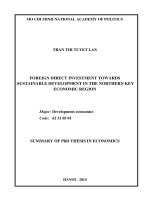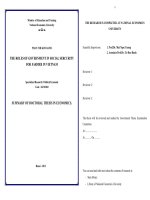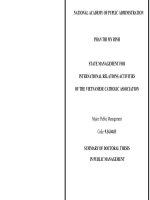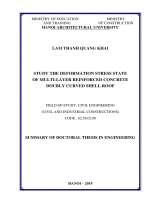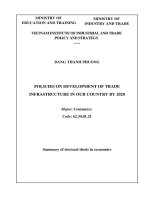Summary of doctorial thesis in business administration human resources training in manuafacturing at south korea’s enterprises in vietnam
Bạn đang xem bản rút gọn của tài liệu. Xem và tải ngay bản đầy đủ của tài liệu tại đây (414.61 KB, 27 trang )
VIETNAM ACADEMY OF SOCIAL SCIENCES
GRADUATE ACADEMY OF SOCIAL SCIENCES
NGUYEN THI OANH
HUMAN RESOURCES TRAINING IN
MANUAFACTURING AT SOUTH KOREA’S
ENTERPRISES IN VIETNAM
Major: Business Administration
Major code: 9 34 01 01
SUMMARY OF DOCTORIAL THESIS
IN BUSINESS ADMINISTRATION
HA NOI - 2020
The thesis was completes at Graduate Academy of Social Sciences
Academic Supervisor: 1. Prof. Dr. Ngo Xuan Binh
2. Dr. Bui Ton Hien
Reviewer 1: Assoc. Prof. Dr. Nguyen Ngoc Son
Reviewer 2: Assoc. Prof. Dr. Ngo Quang Minh
Reviewer 3: Assoc. Prof. Dr. Tran Huu Cuong
The thesis is defended against Academy-level Examination
Board at Graduate Academy of Social Sciences
Time: ………… date………month……….year 2020.
The thesis can be found at: National Library of Vietnam and
Library of Graduate Academy of Social Sciences.
LIST OF AUTHOR'S SCIENCE WORKS
1. Demand for high quality human resources of Korean enterprises
investing in Vietnam, Review Finance, Month 10/2017, ISSN: 005-56,
Tr.54-56
2. High quality human resource training solutions for Korean enterpries
investing in Vietnam, Viet Nam Trade and Industry Review, Month
11/2017, ISSN: 0866-7756, Tr.153-157
3. Factors affecting training production workers at enterprises in Vietnam,
The international journal of business and management, Vol 7, IS 11. ISSN:
2321-8916.
PREFACE
1. Necessity of the thesis
Karl Marx said that: "Human is the most important factor of labor
forces", playing a critical role in the socio-economic development. Today,
with the science and technology development, the world has experienced
the Industry 3.0 and Industry 4.0, the role of human resources is undeniable.
With high-quality skills, human resources plays a key role in the
industrialization and modernization of the country. The workforce has faced
with a substantial and comprehensive transition in production activities,
from manual labor to trained labor and equipped with advanced and modern
technologies, devices and methods to create high labor productivity and
qualitative changes in all social activities1
Industry 4.0 with technological advancements, requiring new
qualitative changes in term of human resources, which was seen as
unskilled human resources, not require high technology. However, the
current technological developments have forced them to change to go with
requirements of modern production lines.
With a young human resources and stability, Vietnam has become an
attractive and safe destination for foreign investors. According to the
General Statistics Office of the 125 countries and territories with new direct
investment projects licensed in Vietnam in 2019, South Korea is the leader
with a total investment of USD 7.92 billion, accounting for 20.8% of total
investment in Vietnam. The development of South Korea’s enterprises '
factories in Vietnam requiring a large amount of skilled workforce, which is
a great opportunity for unskilled labor in Vietnam.
1
/>1
However, in fact, the preparation of the above said human resources
to receive employment opportunities in Vietnam is very low. The physical
health condition of Vietnamese workers is weak at average level, both in
height, weight as well as strength and flexibility, not meet the working
conditions and the requirements for operation of machineries and
equipment following international standards. The labor disciplines of
Vietnamese people in general has not met the requirements in the industrial
production process. It is therefore, most big enterprises have to train
employees in both knowledges, skills, and attitudes, etc. before start of
work. Today, training courses at enterprise is the main solution which are
the foreign enterprises normally conducted to assist workers adapt quickly
to industrial production activities as well as improving labor productivity.
This training process consumes a lot of time and costs of the enterprises,
but there still remains many outstandings in all activities from the
organizing to content of the training such as qualifications and attitudes of
those who come from low educational backgrounds or low socio-economic
background; small enterprises do not have a long-term training plans and
trainners do not have high knowledges, most of the trainnings are often
mentorship.
The research
“Human Resources Training in Manuafacturing at
South Korea’s enterprises in Vietnam" is an in-depth and practical research,
in order to support new South Korea’s enterprises entering the Vietnamese
market and local companies to overview the current status of human
resouces training in manuafacturing. From lessons learnt, each enterprise
will develop their own training plans and roadmaps for their employees to
access quickly to the enterprise’s requirements to improve productivity in
their business.
2
Training procedures at South Korea’s enterprises in Vietnam have
been analyzed, typically for foreign enterprises in general, will assist
Vietnamese laborers and education system to approach the basic
requirements of the international enterprises for earlier and more updated
preparations for the Vietnamese workforce in the integration process. For
that reason, the graduate students select topic "Human resources training in
manuafacturing at South Korea’s enterprises in Vietnam" as the thesis for
Doctor of Business Administration.
2. Purposes and task of research
The thesis comprises the followings:
Theoretical research:
- Systematization of theoretical basis on human resources training in
manuafacturing.
- Study the theoretical framework and analyze the factors affecting
the training of human resources . At the same time, proposing a research
model of factors affecting the training of human resources in South Korea’s
enterprises in Vietnam.
- Practical research:
- Study on the status of human resources training in manuafacturing
at South Korea’s enterprises in Vietnam.
- Study internal the factors affecting human resources training
activities in South Korea’s enterprises in Vietnam (human resources for
input production, training programs, learning culture in enterprises, learning
capacity of employees, remuneration policy, etc.)
- Determine the level of impacts internal of factors on activities of
human resources training in manuafacturing at South Korea’s enterprises in
Vietnam.
- Propose solutions and recommendations to enhance the human
resources training in manuafacturing at South Korea’s enterprises in
Vietnam and some lessons learnt for Vietnamese enterprises.
3
To achieve the purposes of research, the objectives of the thesis are
as follows:
- Overviewing of domestic and foreign research on issues related to
the thesis. These are the contents as a basis for building the research model
of the thesis.
- Building research models on factors affecting Human resources
training in manuafacturing in enterprises.
- Perceiving information and analyze factors affecting the Human
resources training in manuafacturing at South Korea’s enterprises in
Vietnam. Issue general assessments activities for human resources training
in manuafacturing at South Korea’s enterprises in Vietnam.
3. Objectives and scope of research
3.1 Objectives of research
The objective of research is human resources training in
manuafacturing at South Korea’s enterprises in Vietnam.
3.2 Scope of research
- Human resources at South Korea’s enterprises in Vietnam include
human resourcesthat directly operating the machines and participate in
printing products, embroidery clothes, PE tarpaulin and technology
equipment, electronics, etc this thesis do not study and train human
resourceswho work to provide the maintenance and cleaning service for
equipment in the workshop
- The thesis of Human resource training in manuafacturing in
enterprises, ie studying the training of human resources to meet the
production needs of enterprises. The process of training in enterprises
includes skills training, vocational training, rules, etc. to match with the job
and the physical conditions of the enterprises.
- Scope of research: The thesis focuses on researching the human
resources training at South Korea’s enterprises with 100% investment
capital in Vietnam today. particularly, the enterprises: Samsung in Thai
Nguyen; LG Vietnam in Hai Phong; TE VINA Company Limited in Viet
4
Tri - Phu Tho; VINA KOOKJE in Hanoi, Thanh Hoa; HAESUNG VINA
Company in Vinh Phuc province.
- Scope of research: The thesis focuses on research and practical
survey on human resources training in manuafacturing at 5 South Korea’s
enterprises in Vietnam from 2014 to 2018. At the same time, the thesis
chooses research time. research and directions, targets and solutions to
develop training of human resources up to 2030.
4. Methodologies and study of thesis
4.1. Methodologies
To achieve objectives of the research, the thesis aims to respond the
following questions:
Question 1: What are factors affecting the human resources training in
manuafacturing at South Korea’s enterprises in Vietnam?
Question 2: How South Korea’s enterprises in Vietnam conduct human
resources training in manuafacturing? What are the advantages,
disadvantages and reason?
Question 3: What solutions to develop human resources training in in
manuafacturing at South Korea’s enterprises in Vietnam?
Question 4: What are the lessons learnt about the human resources training
in manuafacturing at Vietnamese enterprises?
With scope of the thesis, the author uses the micro-level approach South
Korea’s enterprises in Vietnam and uses qualitative and quantitative
research methods to verify the following research hypotheses.
Hypotheses 1: The human resources training in manuafacturing at some
South Korea’s enterprises in Vietnam has been executed in different forms
and different effects.
Hypotheses 2: Some internal factors affecting the human resources
trainingin in manuafacturing at South Korea’s enterprises: learning culture
of enterprises, remuneration policies, learning capacity of employees,
training programs, human resources input.
5
Hypotheses 3: Develop human resources training in manuafacturing is an
important solution for South Korea’s enterprises in Vietnam.
4.2 Method of research
* Qualitative research: Statistical method; System method; Expert
interview; sociological survey
Quanlitative research
Conducting a survey on assessment of human resources training in
manuafacturing including two types: employees and employers. The topic
uses methods inheriting and using information from secondary sources,
explanations and inductive methods, synthesis and analysis methods,
comparison methods, methods of collecting and analyzing primary and
secondary data.
* Data collection: Collecting primary and secondary data
* Methods of analysis and data processing
Sampling: primary data collected in 2017 and 2018, processed in
2018 and 2019 on the training of human resources of South Korea’s
enterprises in Vietnam, the author proceeds surveys in enterprises. The
author has designed a questionnaire for 03 subjects, i.e. managers, workers
and service staff to collect primary information about the research content.
The total number of questionnaires collected is 282.
Data processing: Using SPSS 22.0 software to analyze correlation to
assess the impact of factors affecting workforce training activities of South
Korea’s enterprises in Vietnam.
5. Output or contributions of the thesis
First, on the basis of research and systematization of documents on
human resources training in manuafacturing at enterprises; the author
inherited the model of factors that affect the human resources training in
manuafacturing and develop a research model on internal factors that affect
the human resources trainingat enterprises.
Second, the thesis analyzes and identifies important factors in the
internal environment of enterprises that affect the training of high-quality
6
human resources in manuafacturing, supporting enterprises to have
appropriate solutions to achieve high outcomes of the training. Enterprises
can evaluate the advantages, disadvantages as well as reasons in order to set
up appropriate and long-term training plans.
Third, setting up orientation for Enterprises plans for their further
finance in human resources training in manuafacturing to respond to the
international economic integration and the Industry 4.0.
Fourth, the solutions in the thesis are documents to support managers
and staff who are in charge of training activities at their enterprises. At the
same time, using the scale to evaluate training activities of each training
course will contribute to improving the quality and efficiency of training at
enterprises.
Fifth, Based on the research results, the author recommends lessons
learnt about human resources training in manuafacturing at enterprises in
Vietnam. This is a new approach of the thesis compared to previously
theoretical studies on assessing the factors affecting the training human
resources in manuafacturing at enterprises.
6. Theoretical and practical significance of the thesis
6.1. Theoretical significance
The thesis will further clarifies employment situation and quality of
human resources training at South Korea’s enterprises in Vietnam. The
results of the Thesis have contributed to the human resources training in
manuafacturing when studying this content in many sectors, getting more
lesson learnts in the way of accessing and analyzing training labor that will
be provided to relevant groups.
6.2. Practical significance
The thesis clarifies the situation of human resources training in
manuafacturing at South Korea’s enterprises; at the same time analyzing,
evaluating and providing suggestions for useful solutions for references of
the staff and human resources training at South Korea’s enterprises in
Vietnam in order to develop appropriate training plans for each enterprise;
7
contribute to the development of South Korea’s enterprises in particular and
Vietnamese enterprise in general.
7. Structure of thesis
The thesis consists of 4 chapters:
Chapter 1: Overview.
Chapter 2: Theoretical and practical significance of human resources
training in manuafacturing at enterprises.
Chapter 3: The current situation of human resources training in
manuafacturing at South Korea’s enterprises in Vietnam.
Chapter 4: Solutions to develop activities for human resources training in
manuafacturing at South Korea’s enterprises in Vietnam
Chapter 1: OVERVIEW
1.1. Overview of issues related to the thesis
The authors Nguyen Ba Ngoc (2011); Nguyen Dinh Phan, Nguyen
Ke Tuan (2007); Bui Ton Hien (2009) supposed that persons participating
in the labor market do not discuss and perform their tasks well, so the
human resources input of enterprises in general have not met requirements
of their business
1.1.1. Overview of issues relating to objectives and roles of human resources
training in manuafacturing
According to Jame R. David Ph. and Adelaide B. David (1998).
Vocational training and human resource development have become a
function of enterprises/institutions since the 18th century and confirmed its
role over time. Nguyen Ngoc Quan, Nguyen Van Diem (2014) gave an
overview of human resource management, planning and allocating human
resources, creating labor motivation.
1.1.2. Overview of tasks and training methods of enterprises
Author Tran Kim Dung (2015) has developed steps of an effective
human resource management process. Nguyen Quoc Khanh (2010) highly
appreciated the role of training and occupational skills development to
8
promote the capacity of employees. Onuka, A.O.U. & Ajayi, Kassim.O
(2012) indicated that training and development is an activity that can
significantly contribute to the overall efficiency and profitability of one
organization.
1.1.3. Overview relating to practical human resources training
activities in manuafacturing
Regarding the lessons learnt about training of other countries,
Nguyen Duy Dung (2008) is based on studies on the historical process of
Korea, Japan which were destructed by war, poor countries; with the
strategy of training and human resources development, have become an
economically, socially developed countries, Ngo Xuan Binh (2012) focuses
on analyzing and evaluating Vietnam - Korea relations since the two
countries established official diplomatic relations (1992) until the end of the
first decade of the twenty-first century.
1.1.4. Overview documents of main factors affecting the training
The research on factors affecting human resources training in
manuafacturing, Nguyen Van Thuy Anh (2014) evaluated the results of
training and development of technical workers of enterprises through
assessment of the level of response technical worker job after being trained
with knowledge, skills, work attitude and future career development ability.
Dinh Thi Hong Duyen (2015) qualitative and quantitative research has
measured the factors affecting the state-of-the-art development in enterprises in
the digital industry.
1.1.5. Overview documents relating to assessment of training activities
A.K.L. Jayawardana et al (2008) said that training effectiveness is
measured by the number of learners who successfully adopted the
knowledge learned to the CV (penetration), and the time consuming for the
learner to apply CV (maintain level) and after how long does TC realize the
overall benefits (speed), training efficiency is influenced by both the
employee and the working environment, beyond the ability to adjust of
employees - also known as organizational factors
9
1.2. Gap and direction of the thesis
Gap of the thesis
Until now, there is no in-depth research on human resources training
in manuafacturing in general and for South Korea’s enterprises in Vietnam
in particular, with the analysis of the influencing factors considering the
characteristics of South Korea’s enterprises made in Vietnam. In the current
context, with the strong development of Industry 4.0 changing the
requirements of production manpower and strong cooperation with South
Korea’s enterprises, there is a need for in-depth research on human
resources not only meeting the requirements of Korean enterprise but also
improving the quality of human resources in Vietnam in the new time.
These are suggestions for implementation of the selected thesis.
* Direction of the thesis
- In terms of theory: The thesis on human resources training in
manuafacturing at enterprises, will clarify: (i) The concept and content of
human resources training activities at enterprises; (ii) Factors affecting the
human resources trainingof enterprises.
- In practical conditions: (i) The thesis will analyze and evaluate the
human resources training activities in manuafacturing at South Korea’s
enterprises in Vietnam on the basis of the established theory; (ii) The thesis
will propose directions and solutions to human resources training in
manuafacturing for South Korea’s enterprises in Vietnam and adoptions to
local enterprises; (iii) The thesis gives some lessons learnt about human
resources training in manuafacturing for Vietnamese enterprises.
In this research, the author focuses on evaluating the human
resources training in manuafacturing at South Korea’s enterprises in
Vietnam for human resources training in terms of knowledge, skills and
attitudes. With the attention, investment and implementation of each
enterprise is different, therefore the training output is also different.
However, South Korea’s enterprises should be proactive in recruitment,
training and remuneration plans to attract and maintain skilled labors.
10
Chapter 2: THEORETICAL AND PRACTICAL BASIS OF HUMAN
RESOURCES TRAINING AT ENTERPRISES
2.1. THEORETICAL BASIS OF HUMAN RESOURCES
2.2.1. Basic concepts
Human resources can be understood as the employees working for
the employers/ owners of industrial production materials, factories,
enterprises and they themselves do not own means of production. Human is
the basic workforce that directly or indirectly participates in the production
process, reproduces materials, including direct and indirect human
resources .
Human resources training in manuafacturing is to train the workforce
to directly create products in the enterprise, so the human resources training
is to provide thelaborers with knowledge and skills to help them to increase
productivity at work. Human resources training in manuafacturing may
include training of technology; training skills and techniques in
manipulation; training work steps and quality management processes.
In this thesis, the author studies human resources directly operating
the machine and participating in the production of printing products,
embroideries, PE tarpaulins and technology equipment, electronics, etc. The
thesis does not study human resources training in manuafacturing for those
who work to maintain and clean equipment in the workshop, etc. At the
same time the author uses the viewpoint of human resources training in
manuafacturing as knowledges, skills and attitudes for each employees to
complete their jobs with high outcomes , and at the same time adapt to the
requirements of production activities at the enterprises.
2.1.2. Role of human resources training in manuafacturing
*To the enterprises:
- To help enterprises attract potential human resources
- To help enterprises compensate for the shortage of manpower
- To help enterprises improve existing human resources
11
* For employees: Update new knowledges and skills, successfully apply
technological or technical changes.
2.2. Human resources training process in enterprise
2.2.1. Determine objectives and assess training needs
Each enterprise needs to have specific goals to improve the quality of
human resources trainingin enterprises. One of the basic goals of training is
to change Knowledge, Behavior and Attitude towards a positive direction to
improve knowledge and adaptions of the learners.
2.2.2. Develop training programs
The training program indicate all content that need to be trained, what the
learners can achieve after joining the program; outlines the process needed to
implement training content, training methods and how to test and assess learning
outcomes with specific time schedule
2.2.3. Organize training activities in the enterprises
Implement training courses
Incentive policies in the training process
2.2.4. Evaluate training results and the use of human resources after
training
Evaluation of the training results of human resources of enterprises
means assessing the level of the response to the job requirements on the
practical capacity of the workers through training and the ability to develop
in the future of human resources training, focusing on to the following
levels:
- Responding capacity to job requirements in terms of skills;
- Knowledges
- Labor behavior and attitudes
- Ability to develop careers
2.3. Factors affecting human resources training activities in enterprises
The thesis studies and evaluates training activities and analyzes the
factors affecting the training of human resources , including 2 factors: (1)
The factors impacting from the environment outside the enterprise; (2)
12
Factors affecting from within enterprises. The research model of the Thesis
is developed on the characteristics, overview of studies, interviews of
experts and employees about the factors affecting training activities of
human resources of South Korea’s enterprises in Vietnam.
External environmental factors
globaliz
ation
trend
and
Industry
4.0
Training
program
Learning
capacity
Human
resource
inputs
Internal
environment
factors
Learning
culture
Remuneration
policies
Sector characteristics and labor market
M
ec
ha
nis
m
an
d
po
lic
ies
of
the
Go
v
Figure 2.1: Research model of factor affecting human resources
training activities in the enterprises
2.3.1. External factors affecting the human resources training of the
enterprises
The external factors create opportunities as well as challenges for
businesses. For foreign investment activities in enterprises, the main factors
including globalization trends and the Industry 4.0; mechanisms and
policies of the Government on human resources training; sector
characteristics and labor market, etc.
2.3.2. Internal factors affecting the human resources training in
manuafacturing of the enterprises
2.3.2.1. Input of human resources
2.3.2.2. The learning culture of the enterprise
2.3.2.3. The learning capacity of employees
13
2.3.2.4. Remuneration policy of the enterprise
2.3.2.5. Training program for employees at the enterprise
2.4. Practical situation of human resources training in manuafacturing of
foreign enterprises in Vietnam
2.4.1. Toyota Vietnam
2.4.2. Unilever Vietnam
2.4.3. Honda Vietnam
2.4.4. Lessons learnt for enterprises
First, implementing an enterprise training model to increase highquality human resources to meet the requirements of developing production
and business activities.
Second, enterprises need to focus on investment to develop
education and training for new and old employees, and must really consider
training as the most important factor.
Third, human resources training following the actual needs of
businesses.
Fourth, pay attention to create good conditions for potential human
resources.
Fifth, build a relationship between training schools and businesses.
Sixth, human resources training must be based on inheriting and
promoting traditional cultural values combined with receiving human
cultures.
Chapter 3: ACTUAL SITUATION OF HUMAN RESOURCES
TRAINING IN MANUAFACTURING AT SOUTH KOREA’S
ENTERPRISES IN VIETNAM
3.1. General characteristics of South Korea‘s enterprise in Vietnam
South Korea is the leading partner of Vietnam, first ranking in FDI
and second ranking in ODA, the following is Japan, Singapore, etc.
Accumulative data by February 2019, the total registered investment capital
of Korea reached USD 63.7 billion, accounting for 18.5% of total registered
14
FDI capital in Vietnam. In 2018, South Korea had 953 projects granted
investment certificates with a total registered investment capital of USD 6.8
billion, accounting for 22.3% of the total registered FDI capital in Vietnam.
Korean FDI enterprises employ about 70,000 people and contribute over
25% of the total export amount of Vietnam. In the field of manufacturing
industry, the involvement of major economic corporations as Samsung, LG
(manufacturing), Kumho, Doosan, Hyundai, GS, Posco (heavy industry and
shipbuilding ) has significantly impacted on the development of industries
in Vietnam; especially gas, metallurgy, chemicals, electricity-electronics,
plastics, etc.
3.2. Some South Korea‘s Companies in Vietnam
3.2.1. Samsung Electronics Vietnam Company Limited
Samsung is a leader in investment in Vietnam market. In 2012,
about two years after Samsung opened its first mobile device manufacturing
factory in Bac Ninh, Vietnam started exporting more than it imported for
the first time for 20 years. After the company opening the second
smartphone production factory in Thai Nguyen in 2013, 17% of Vietnam's
total exports sourced from Samsung. Samsung employed about 173,500
workers in Vietnam, most of them work at two smartphone factories in Bac
Ninh and Thai Nguyen provinces.
3.2.2. LG Electronics Vietnam
LG Electronics is a leader in technology, founded in Korea in 1958,
has a global scale with a presence in over 119 countries with more than
86,000 employees. LG Electronics was officially present in Vietnam in
1995, the head quarter based in Hanoi. The factory in Hai Phong opened in
Mar 2015 on an area of 800,000 m2 and a total investment of up to USD
1.5 billion, marking the 20-year development of LG in the Vietnamese
market with over 10,000 employees
3.2.3. Te wang Vina Company
Te wang Vina company was established in 2003 with 100% foreign
investment. The company currently has 350 workers. Main products
15
produced and consumed: Specializing in the production of PE tarpaulins for
domestic and export markets.
3.2.4. Vina Kookje Company
VINA KOOK JE CO., LTD (VINA KOOK JE CO., LTD.) funded
100% of charter capital by KOOK JE (Korea), in cash and equipment.
Number of staff - workers at the computerized embroidery factory and the
grid printing factory: 200 people. The main business areas of the Company:
processing products are computerized embroidery and grid printing of
100% exported garment products.
3.2.5. Haesung Company
Haesung Vina Co., Ltd, abbreviated name is HAESUNG VINA
Co., Ltd has its office in Lot CN7, Khai Quang Industrial Park, Vinh Yen
City, Vinh Phuc province. Haesung Optics Company is one of the
enterprises with strengths in the field of research and manufacture of optical
and optoelectronic equipment. Currently, there are over 4,250 experts and
employees working for the Company.
3.3. Actual situation of human resources training in manuafacturing at
South Korea’s enterprises in Vietnam
3.3.1. Training needs and objectives
At Samsung, people are always considered the most important
factor. Therefore, Samsung always pays special attention to training
programs, developing human resources with the goal that each Samsung
employee is not only good at expertise, but also has a broad cultural and
social knowledge. LGEVH often organize training needs assessments in a
formal and methodical manner. For TE Vina company and Vina Kookje
company, training needs are determined by the company's managers,
meeting the company's production and business objectives in each stage.
3.3.2. Developing training program
For large-scale companies such as Samsung, LGEVH, the training
and development of human resources for production in South Korea’s
enterprises in Vietnam is based on basic tasks including: assessment of
16
training needs designing training programs, implementing training
programs and evaluating the outcomes of training. At Samsung, they
designed programs to train employees in essential skills for the job, training
courses to improve skills, improve the professional qualifications of
employees are strongly developed.
However, Heasung Vina is also a large-scale company or a small
Korean company in Vietnam such as Teawang Vina, Vina Kookje, that do
not have periodic or annual training plans. After each recruitment phase,
workers will be trained in integration with businesses and guided
apprenticeship in the workshop. Training content at LG is always designed
and communicated by lecturers in accordance with the actual work
requirements; Training content of Vina Kookje company: Organization and
operation charter; Labor regulations of the company; Company processes,
regulations, work documentation, and other documents.
3.3.3. Organizing training activities
Samsung Company make agreements with associated universities
and colleges so that its employees can study for free at night time in the
factory. They can learn English and Korean languages, as well as
accounting and electronics engineering.
For HEASUNG, the Company periodically inspects equipment that
strictly required to follow regulations on occupational safety and health and
fire prevention, and rescue for all employees of the company, establishing a
network of fire and explosion prevention and safety personnel arranged
throughout the workshop. The company also signed a cooperation
agreement with the Hanoi University of Science and Technology to
establish a research and development center for optoelectronics.
3.3.4. Assessing the results and use of laborers after training
Throughout the survey of 282 employees in 5 companies on the training
results following Kichpatrick’s 4-level model, the above results indicated
that the training program of human resources of South Korea’s enterprises
in Vietnam is develop and to achieve the employee's desires with a
17
satisfaction level of 83% (equivalent to 4.16 points). The ability to absorb
knowledge, skills and improve employee's attitude is also quite high (81%,
equivalent to 4.06 points). The level of practicality and ability to apply
trained contents to a specific job is 79% (3.97 points) and the increase in
labor output as assessed by managers and employees is 76%. (3.8 points).
This is an encouraging result and also confirms that human resources
training activities are effective in enterprises.
3.4. Analyzing factors affecting human resources training activities in
manuafacturing at South Korea’s enterprises in Vietnam
Quantitative analysis and Exploratory Factor Analysis (EFA) scale of
factors affecting the training human resources in manuafacturing at South
Korea’s enterprises in Vietnam include: P - Training programs, C Learning Culture of enterprises, A - Self-study capacity of employees and B
- Remuneration policy. The results indicated that all the variables met the
requirements and the model was consistent with the study. The regression
equation has the form:
E = -0.196 + 0.375P + 0.282 C + 0.233A + 0.157 B
3.5. General assessment of human resources training actives in
manuafacturing of South Korea’s enterprises in Vietnam
3.5.1. Advantages
- Training policies and procedures are relatively clear
- Enterprises always create all favorable conditions for employees to
improve their own education and skills.
- The majority of Korean businesses developed specific training procedures.
The training program is always carefully designed and suitable for each
course and participants.
- The enterprise constantly innovates human resources training in
manuafacturing, applying various training from on-the-job training to
sending personnel for outside enterprise training has achieved good results.
- The contents and training methods in enterprises are relatively
appropriate, closely with the actual situation for manufacturing.
18
3.5.2. Disadvantages
- The enterprises have not established a long-term training plan; Training
methods are primarily on-site mentoring and response to immediate job
requirements.
- Each step in the training process is not specified yet. The identification of
training needs is not clearly defined, as well as the development of specific
needs assessment methods for each department is only based on the
subjective assessment by the Head of team or group to determine training
needs.
- The training content is mainly based on skilled human resources at
enterprises; Applying the form of on-the-job training for the workers
directly engaged in production and some staff in departments.
- The ability to coordinate internally among sections and divisions in
enterprises is still limited, sometimes it has not created a uniform working
sense of responsibility and there is no mutual support and sharing at work.
- The expenses for human resources trainingare not much be funded by
enterprises.
- The evaluation of training performance is still general, not practical at
work, it does not reflect the level of work completion, does not create
motivations to encourage employees to work well.
- SMEs do not have policies and incentives to employees who achieved
with high scores in training. In addition, the enterprise did not have any
sanction or penalty against those who did not complete the training course.
3.5.3. Reasons
The training activities at South Korea’s enterprises in Vietnam still
remain some limitations due to the reasons i.e it may be caused by trained
employees; or by enterprises.
19
Chapter 4: SOLUTIONS FOR HUMAN RESOURCES
TRAINING IN MANUAFACTURING AT SOUTH KOREA’S
ENTERPRISES IN VIETNAM
4.1. Context, orientation for human resources training at Korean
Enterprise and local enterprise up to 2030
4.1.1. Socio-economic development in Vietnam affecting the human
resources training in manuafacturing at enterprises
Today with rapid development of the Industry 4.0, machines and
devices can be connected without requiring human involvement and/
or intervention, about 75% of the informal labourers in Vietnam are in high
risk of job loss. Therefore, old methods or traditional methods of human
resources training with lack of interaction, without examples of new
production model, cannot be conservatively followed. Training
institutions/centers need to strongly shift the training from "supply" to
"demand" of enterprises and the local labor market; at the same time
increasing the competitiveness of human resources in the regional and
international labor markets, to meet the requirements of regional and
international integration.
4.1.2. Orientation of activities for human resources training in
manuafacturing at South Korea’s enterprises in Vietnam and local
enterprises up to 2030
- Enterprises coordinate with high schools to show students to follow
vocational programs or academics.
- Enterprises need to invest in training and provide long-term training
plans for their employees.
- Enterprises support vocational training schools to improve teaching
quality and invest in practical equipment and technology to meet the job
requirements in their businesses.
20
- Human resources must meet the requirements of knowledge, skills,
attitudes and behavior to match with new trend of large production
enterprises,
4.2. Solution for human resources training activities at Korean
enterprise in Vietnam
4.2.1. Implementing effective training program
In order to develop an effective training program for employees,
methodical steps must be followed be enterprises: Determining training
needs and objectives; fundings for training activities; design appropriate
training programs; implement and manage the training program; and
evaluation of training program.
4.2.2. Learning culture in the enterprises
South Korea’s enterprises in Vietnam is requested to promote good
values, advanced Corporate Culture in Korea to establish and maintain good
behaviors for their employees in Vietnam.
4.2.3. Improving learning capacity of employees
In order to improve the learning capacity of employees in enterprises,
it is essential to improve the employees' ability in term of leaning and
absorbptive capacity as well as the learning awareness and attitude of the
employees.
4.2.4. Remuneration policies for employees
Enterprises set out long-term policies as well as regulations for
employees before and after the training process, i.e. policies to support
funding and create favourable conditions for employees to study at local
vocational training institutions/centers or abroad; employees must be
assigned jobs, after being trained, to match with their qualifications and
capabilities; rewards and penalties for employees and regularly priority
training policies for laborers who work well and wish to develop their
knowledge and have long-term commitment to the enterprise.
4.3. Recommendations to the Government
- Policies to attract investment capital from abroad
21
- Policies on human resources training in manuafacturing at South
Korea’s enterprises in Vietnam and local enterprises
4.3.2. Recommendations to Associations, Government’s agencies
Ministries of Industry and Trade, Education and Training, the
General Department of Vocational Training under Ministry of Labor,
Invalids and Social Affairs and Associations in Vietnam coordinate to
implement policies to support training activities in enterprises.
- Technical and financial support for small and medium scale enterprises
4.3.3. Recommendations to training institutions/centers
Training institutions/centers need to strengthen communication
activities for vocational training support policies and job creation for work
force; focusing on prediction of the needs of local human resources in the
coming years; enhance coordination with departments, sectors, local
authorities and schools in consulting recruitments, vocational training with
learning cultural for students of secondary schools and high schools
4.4. Lessons learnt
4.4.1. Training contents and methodologies
- Promoting efficient application of Information Technologies in teaching
process.
- Encouraging employee to develop their self-directed learning
- Motivating employees for teamwork.
- Regularly organizing meeting to promote the exchange or sharing
experiences between employees.
4.4.2. Effective training management
Each course, based on the target of the enterprise, to develop specific,
appropriate training programs for the trainers subjects in actual conditions.
4.4.3. Fundings for training activities
- Identifying the importance of human resources training affecting the
sustainable development of enterprises.
- Investing funds and facilities and equipment for training in the company.
- Developing plans and arranging costs for each activity of the training
22
